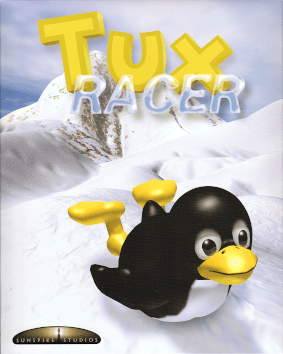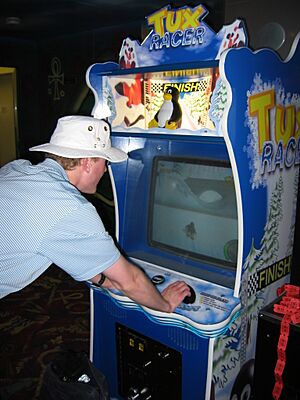Tux Racer facts for kids
Quick facts for kids Tux Racer |
|
|---|---|
 |
|
| Developer(s) | Sunspire Studios |
| Publisher(s) | Sunspire Studios |
| Director(s) | Jasmin Patry |
| Composer(s) | George Sanger Joseph Toscano |
| Platform(s) | Linux, Windows, Mac |
| Release date(s) | Linux:
|
| Genre(s) | Racing |
| Mode(s) | Single-player |
Tux Racer is an exciting racing video game from 2000. It features Tux the penguin, who is the mascot for Linux computers. This game is also open-source, meaning its code can be freely used and changed by anyone.
The game was first created by Jasmin Patry. He made it for a computer graphics project at the University of Waterloo. Later, he and other former students formed Sunspire Studios. They worked together to make the game even better. In Tux Racer, you control Tux as he slides down snowy and icy courses. Your goal is to collect tasty herrings along the way.
Tux Racer became very popular. By 2001, it was downloaded over one million times. People loved its cool graphics and fast gameplay. It was a big hit with Linux users and the free software community. Because it was so popular, a special paid version was made. This version had better graphics and allowed multiple players. Tux Racer also became the first game with a GPL license to be made into an arcade game. Sunspire Studios only made this one game before closing down.
Contents
How to Play Tux Racer
Tux Racer is a fun racing game. You guide Tux down a mountain. Tux can turn left or right. He can also brake, jump, and paddle his flippers.
- Turning and Braking: If you press the brake and turn buttons, Tux will make a sharp turn.
- Gaining Speed: Paddling on the ground helps Tux go faster. But if the speed meter turns yellow, paddling will slow him down.
- Jumping and Flying: Tux can launch into the air from slopes. While in the air, he can flap his flippers to fly farther. You can also steer him left or right.
- Getting Unstuck: If Tux gets stuck, you can reset him to a safe spot.
Course Features and Scoring
The courses have different types of ground. Each ground type affects Tux's speed and control.
- Ice: Sliding on ice makes Tux go very fast. However, it's harder to steer.
- Snow: Snow gives Tux more control. It's easier to turn and maneuver.
- Rocks and Trees: Watch out for rocky patches and trees! Hitting them will slow Tux down.
You earn points by collecting herrings on the course. The faster you finish, the more points you get.
Game Modes and Challenges
You can play in "cups." To move forward in a cup, you must meet certain goals. These goals include:
- Collecting enough herrings.
- Finishing the course within a set time.
- Earning enough points.
If you don't meet all the goals, or if you quit a race, you lose a life. You start with four lives. If you lose all of them, you must restart the entire cup.
Before a race, you can choose the time of day. You can also pick weather conditions like wind or fog. These choices change how the game plays.
Special Features in the Paid Version
The paid version of Tux Racer added new and exciting things.
- New Characters: Besides Tux, you can play as Samuel the seal, Boris the polar bear, or Neva the penguin.
- Power-ups: Some courses have jump pads and speed pads. These give you a boost!
- Tricks: You can do cool tricks in the air to earn extra points.
- Game Modes: You can play "Solo Challenge" like the original game. There's also "Race vs Opponents," where you race against a computer player. You must beat them to move on.
- Unlocking Courses: Finishing cups unlocks new courses.
- Multiplayer: You can race a friend in "Head to Head" mode. This uses a split-screen so both players can see their view.
How Tux Racer Was Made

Jasmin Patry, a student at the University of Waterloo in Canada, first created Tux Racer. He wanted to work in video games. He started making the game in August 1999 as a final project. It took him only three days to finish! His classmates really liked it.
Jasmin then made a website for the game. Someone suggested he share the game's code for free. This made sense because Tux is the mascot for Linux, which is open-source. So, on February 28, 2000, Jasmin put the game online for Linux users. He hoped others would help improve it. This early version was simple. Tux just slid down hills with snow, ice, and rocks to avoid. Jasmin used free images and textures he found online to build the game.
In December 1999, Jasmin and other students formed Sunspire Studios. They planned to make a huge online game. But it was too big of a project for them at the time. So, in August 2000, they decided to work on Tux Racer instead.
They quickly added many new features to the free version. In just three weeks, they added herrings, jumping, and music. They also made the graphics much better. It was easy to make the game work on Windows computers too. This was because it used tools like OpenGL and Simple DirectMedia Layer, which work on many different computer systems.
A big update, version 0.60, was released for free on October 2, 2000. It was available for both Linux and Windows. Many Linux computer systems included a small update for this version. A version for Macintosh computers came out on November 21, 2000.
Later Versions and Arcade Game

On February 5, 2002, Sunspire Studios released a paid version of Tux Racer. You could buy it in stores on a CD. This CD worked on both Linux and Windows computers. This new version had much better graphics and a stronger game engine. It also let players do tricks, choose different characters, and play against others. The original free version of Tux Racer stayed available online. Sunspire Studios stopped making games around the end of 2004.
Since then, fans have made their own updates to Tux Racer. One popular example is Extreme Tux Racer, which came out in September 2000. There was even an arcade version of the game made by Roxor Games. This made Tux Racer the first game with a GPL license to be turned into an arcade machine!
See also
 In Spanish: Tux Racer para niños
In Spanish: Tux Racer para niños
- SuperTuxKart, another racing video game featuring Tux and friends

